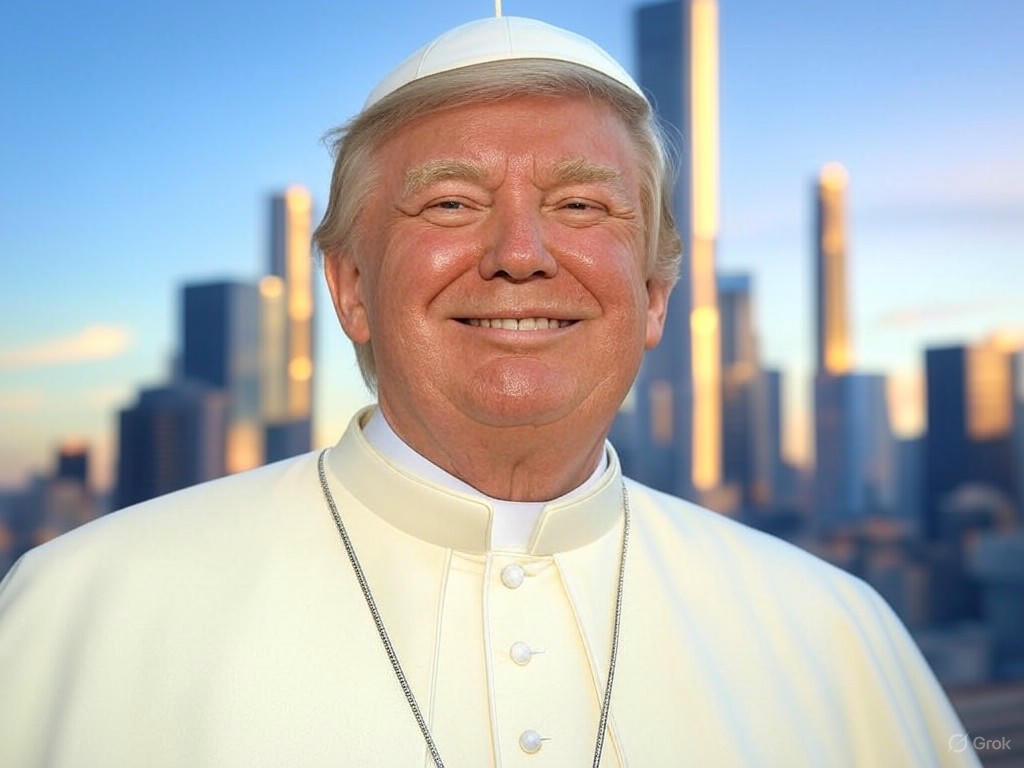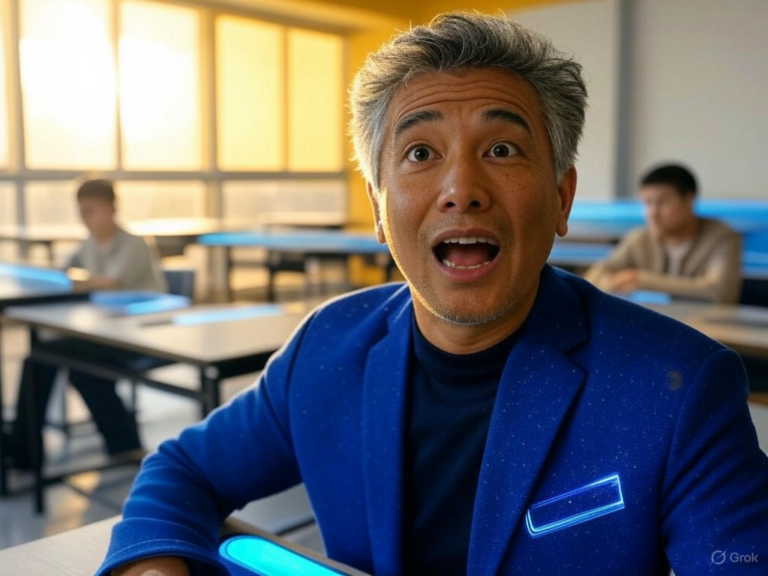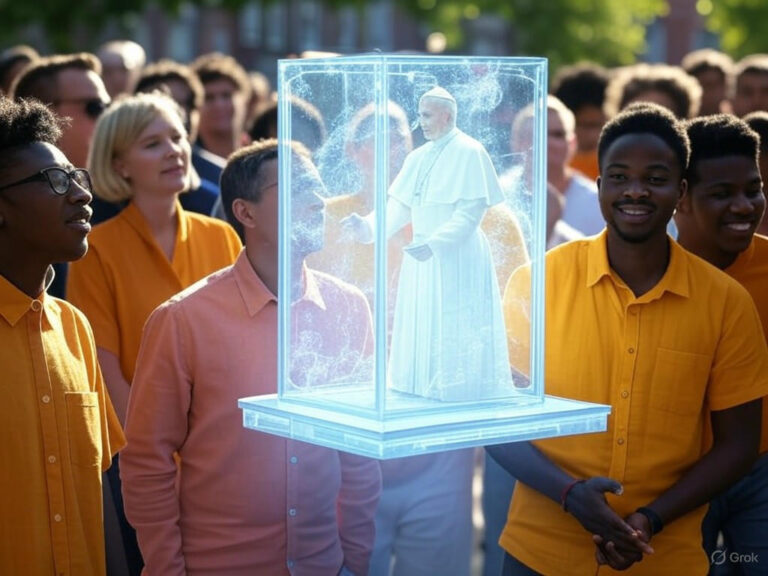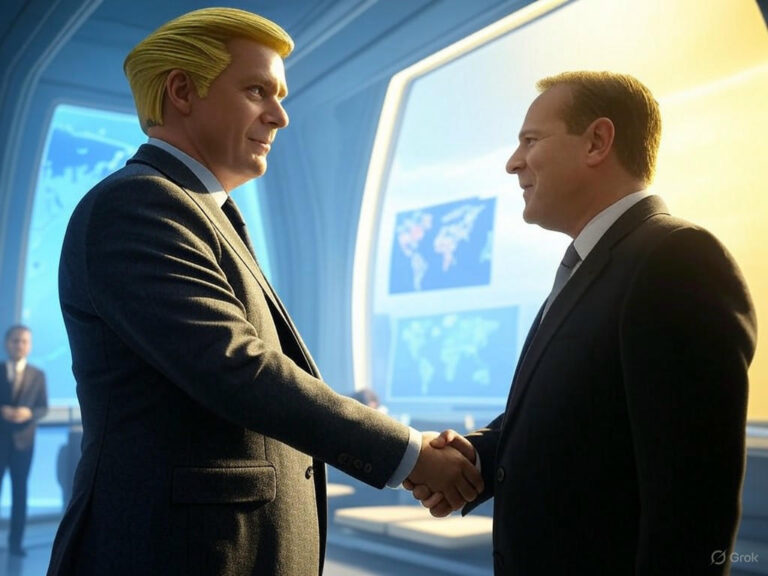
AI Pope Image Trump’s Positive Catholic Response
Trump’s Defense of the AI Pope Image During Vatican Mourning
Picture this: In the midst of a solemn period, a playful yet provocative image hits social media, stirring up conversations far beyond its intended humor. President Donald Trump shared an AI-generated depiction of himself dressed as the pope on Truth Social, which quickly spread to the White House’s X account, drawing sharp criticism amid the Vatican’s nine-day mourning for Pope Francis, who passed away on April 21, 2025. This Trump pope image, as it’s being called, landed right before the conclave to choose the next pope, turning a moment of reverence into a flashpoint of debate.
When reporters pressed Trump about the backlash during an Oval Office event announcing Washington as the host of the 2027 NFL Draft, he brushed it off with his signature style. “You mean they can’t take a joke,” he quipped on May 5th, insisting that “the Catholics loved it” while pointing fingers at the media for stirring the pot. Have you ever shared something online that you thought was funny, only to face unexpected criticism? This incident shows how quickly digital content can escalate, especially when it involves sensitive topics like faith and leadership.
The Trump pope image controversy highlights the fine line between satire and disrespect, particularly in religious contexts. Critics argued that the timing was ill-advised, as the Vatican focused on daily Masses in memory of the late pope. Yet, Trump maintained it was all in good fun, distancing himself from its creation by saying, “Somebody made up a picture of me dressed like the pope—I know nothing about it.” If you’re navigating social media in a professional role, this serves as a reminder to think twice about what you share and how it might land with different audiences.
Timing and Context Surrounding the Trump Pope Image
As the world geared up for the papal conclave set to begin on Wednesday, the release of this AI-generated image couldn’t have been more poorly timed. It showed Trump in traditional papal attire—a white cassock and miter—amid a period meant for reflection and prayer. For Catholics, especially in Italy, where the pope’s role is deeply woven into cultural and spiritual life, the death of a pontiff like Pope Francis marks a sacred transition, symbolizing Christ’s presence on Earth.
This Trump pope image emerged just days before cardinals would sequester themselves for the vote, a process designed to shield the Church from external influences. Imagine the cardinals, already under immense pressure, dealing with headlines about a meme gone wrong—it’s a stark reminder of how global events can intersect with age-old traditions. If you’re following international news, you might wonder: How do modern tools like AI complicate these historic rituals, and what does that mean for respect in digital spaces?
In the broader context, the image fueled discussions about AI’s role in shaping public perception. While some saw it as harmless entertainment, others viewed it as a disrespectful nod during a time of grief. This event underscores why understanding cultural sensitivities is key, especially for leaders in the public eye—after all, a single post can ripple across borders and beliefs.
Exploring the Origins of the Trump Pope Image
Trump was quick to clarify that he didn’t create the image, attributing it to some anonymous online creator, possibly using AI tools. “I only saw it the night before,” he explained, adding that his wife, Melania, found it amusing and “cute.” It’s fascinating how personal reactions can influence public decisions; in this case, a lighthearted family moment led to a widespread controversy.
But let’s pause and think: In an era where AI can whip up realistic images in seconds, how do we separate fun from offense? Trump joked about the impracticalities of papal life, like the no-marriage rule, saying, “Popes aren’t big on getting married, are they?” This human touch in his response made the situation feel more relatable, even as critics piled on. For anyone creating or sharing content, it’s a lesson in balancing humor with awareness of its potential impact.
Catholic Leadership’s Take on the Trump Pope Image
Despite Trump’s claim that Catholics embraced the image, several high-profile church figures begged to differ. Cardinals like Timothy M. Dolan of New York and Bishop Robert E. Barron voiced their disapproval, especially given Trump’s own appointments to religious commissions. Bishop Thomas J. Paprocki went further, calling for an apology and labeling it “deeply offensive” during this mourning period.
The Trump pope image debate extended to Vatican briefings, where Italian and Spanish media described it as tasteless. This pushback raises an important question: How should political figures engage with religious symbols without crossing lines? For instance, if you’re in a position of power, consider how your actions might affect communities that hold those symbols dear—it could strengthen or strain relationships.
In my view, this incident illustrates the challenges of modern diplomacy. While Trump saw it as a meme, others perceived it as mocking a sacred institution, highlighting the need for cultural empathy in global communications.
Vatican’s Specific Reaction to the Trump Pope Image
At the Vatican’s daily conclave briefing, the image became a hot topic, with reports emphasizing its poor taste. Officials didn’t issue a formal statement, but the undertone was clear: This wasn’t the moment for levity. It’s a prime example of how digital content can influence international relations, even unintentionally.
If you’ve ever dealt with backlash from a post, you know how quickly things can escalate. Here, the Vatican focused on honoring Pope Francis’s legacy, making the Trump pope image feel like an unwelcome distraction. Leaders might learn from this by prioritizing context and timing in their messaging strategies.
Political Ramifications of the Trump Pope Image
Beyond the immediate fuss, this controversy ties into Trump’s broader relationship with the Vatican. His nomination of Brian Burch as ambassador to the Holy See adds another layer, especially with Burch’s organization covering conclave developments. There’s speculation about how this might affect U.S.-Vatican ties, particularly with figures like Cardinal Pietro Parolin in the mix as a potential papal candidate.
Trump even threw in his two cents on the succession, praising Cardinal Dolan as a strong contender. Yet, as Vatican lore goes, too much outside hype can backfire—entering as a favorite often means leaving without the title. This Trump pope image episode could subtly influence perceptions, reminding us that every action in politics has ripple effects. What if more leaders used AI for engagement? It might open doors, but it also risks closing them with unintended offense.
For anyone interested in politics, this is a case study in balancing personal style with diplomatic caution. Trump’s approach, while bold, underscores the importance of reading the room before hitting “share.”
Social Media Buzz Around the Trump Pope Image
Online reactions to the Trump pope image were mixed, with social platforms buzzing from memes to heated debates. Supporters laughed it off as typical Trump flair, while critics decried it as insensitive, especially during the mourning for Pope Francis. This event fits into a larger pattern of the administration’s provocative online presence, raising questions about the boundaries of official accounts.
Think about your own social media feeds—how often do viral posts spark real-world consequences? In this case, it amplified discussions on AI ethics and religious respect. By blending humor with controversy, the image kept the conversation alive, but it also highlighted the risks of digital missteps.
For content creators, this serves as a tip: Always consider the audience and context to avoid alienating groups. Could incorporating AI responsibly enhance your outreach without causing harm? Absolutely, if done thoughtfully.
Historical Background of Papal Transitions and the Trump Pope Image
Papal elections are rich in history, with the conclave process dating back centuries to prevent outside interference. The death of Pope Francis triggered the traditional novendiales, a nine-day period of mourning and prayer, emphasizing solemnity and spiritual focus. Against this backdrop, the Trump pope image felt jarringly out of place, like a modern intrusion into an ancient ritual.
Historically, secular leaders have tried to sway these events, which is why cardinals are kept isolated. This incident echoes those tensions, blending today’s tech with timeless traditions. If you’re a history buff, you might appreciate how the Trump pope image inadvertently spotlighted this ongoing dance between power and faith.
In a hypothetical scenario, imagine if AI had existed during past conclaves—would it have changed outcomes? Probably not, but it certainly adds a new layer to how we view influence today.
Wrapping Up: Humor, Respect, and the Trump Pope Image Legacy
In the end, the Trump pope image controversy boils down to a clash between lighthearted fun and the need for reverence. While Trump framed it as a hit with Catholics, the varied responses from leaders and the public show it’s not that simple. This moment reflects broader challenges in our digital world, where a quick laugh can lead to diplomatic ripples.
So, what are your thoughts on blending politics and religion online? If you’re passionate about these topics, consider sharing your perspective in the comments below—it could spark some insightful discussions. For more on AI’s role in society or current events, check out our related posts on emerging technologies.
As we look ahead, remember that thoughtful communication can bridge divides. Whether you’re a leader or just an everyday user, aim to use tools like AI in ways that build understanding rather than barriers. Thanks for reading—feel free to subscribe for updates on stories like this.
References
- PBS NewsHour. “AI-generated image of Trump as the pope draws criticism ahead of papal conclave.” Accessed via PBS.
- YouTube Video. “Trump dismisses criticism of AI image.” View on YouTube.
- OSV News. “Trump dismisses criticism of AI image showing him as pope.” OSV News Article.
- Fox 7 Austin. “Trump pope AI image sparks debate.” Fox 7 Austin Coverage.
- Gemesys Research. General resource. Gemesys Research Site.
- Presidential Secretariat of Sri Lanka. Related context. PSC WP Site.
Trump pope image, AI generated pope Trump, Catholic response Trump, papal conclave 2025, White House social media controversy, Trump Vatican relations, AI in politics, religious sensitivities, papal mourning period, digital diplomacy






